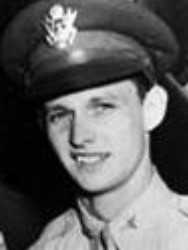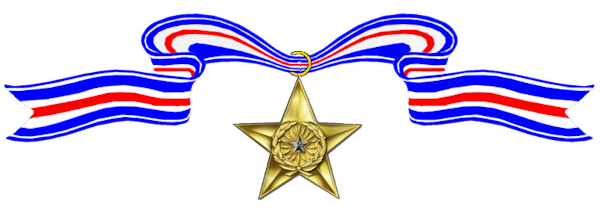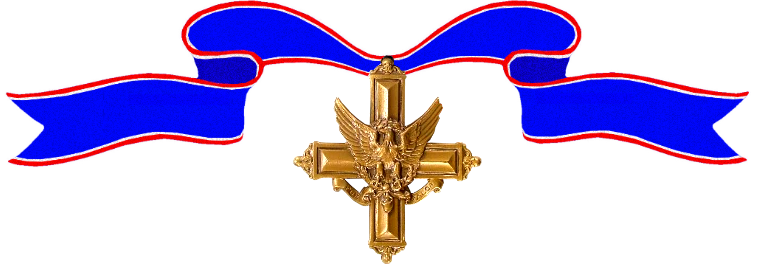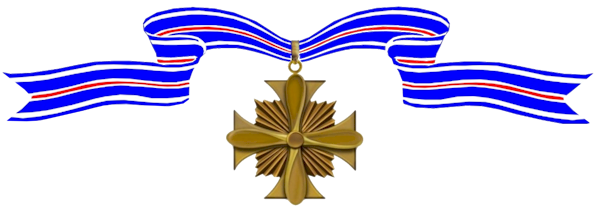George Welch was the first American Air Force pilot to shoot down a Japanese airplane in the Pacific. He continued to serve throughout the war, becoming a U.S. Army Air Forces TRIPLE ACE, credited with destroying 16 enemy aircraft in aerial combat. After the war he transferred to the new U.S. Air Force. On October 12, 1954, he was killed testing an F-100 Super Sabre.

–
Cemetery:
Awards Received
-

Silver Star
-

Distinguished Service Cross
-
Silver Star
Service:
United States Army Air ForcesRank:
Captain (Air Corps)Batallion:
80th Fighter SquadronRegiment:
8th Fighter GroupDivision:
5th Air ForceAction Date:
World War II
Headquarters, V Fighter Command, General Orders No. 5 (February 16, 1943)(Citation Needed) – SYNOPSIS: The President of the United States of America, authorized by Act of Congress July 9, 1918, takes pleasure in presenting the Silver Star to Captain (Air Corps) George Schwartz Welch (ASN: 0-398557), United States Army Air Forces, for gallantry in action against the enemy while serving as Pilot of a P-40 Warhawk Fighter Airplane of the 80th Fighter Squadron, 8th Fighter Group, FIFTH Air Force, in aerial operations in the Southwest Pacific Theater of Operations, in 1942 and 1943. The gallant actions and dedicated devotion to duty demonstrated by Captain Welch, without regard for his own life, were in keeping with the highest traditions of military service and reflect great credit upon himself and the United States Army Air Forces.
-
Distinguished Service Cross
Service:
United States Army Air ForcesRank:
Second Lieutenant (Air Corps)Batallion:
47th Pursuit SquadronRegiment:
18th Pursuit GroupDivision:
Hawaiian Air ForceAction Date:
December 7, 1941
War Department, General Orders No. 2 (January 5, 1942)The President of the United States of America, authorized by Act of Congress, July 9, 1918, takes pleasure in presenting the Distinguished Service Cross to Second Lieutenant (Air Corps) George Schwartz Welch (ASN: 0-398557), United States Army Air Forces, for extraordinary heroism in connection with military operations against an armed enemy while serving as Pilot of a P-40 Fighter Airplane in the 47th Pursuit Squadron, 18th Pursuit Group, HAWAIIAN Air Force, in action over the Island of Oahu, Territory of Hawaii and waters adjacent thereto, on 7 December 1941. When surprised by a heavy air attack by Japanese forces on Wheeler Field and vicinity at approximately 8 a.m., Lieutenant Welch left Wheeler and proceeded by car, under fire, to Haleiwa Landing Field, approximately ten miles distance, where his squadron’s planes were stationed. Immediately, on his own initiative, he took off for the purpose of attacking invading forces, without first obtaining information as to number or type of Japanese in the attacking force, and proceeded to his initial point over Barbers Point. At time of take off he was armed only with thirty-caliber machine guns. Upon arrival over Barbers Point, he observed a formation of approximately twelve planes over Ewa, about 100 feet below and ten miles away. Accompanied by only one other pursuit ship, he immediately attacked this enemy formation, shooting down an enemy dive bomber with one burst from three .30-caliber guns. At this point one .30 gun jammed. While engaged in this combat, his plane was hit by an incendiary bullet which passed through the baggage compartment just in rear of his seat. He climbed above the clouds, checked his plane, returned to the attack over Barbers Point and immediately attacked a Japanese plane running out to sea, which he shot down, the plane falling in the ocean. No more enemy planes in sight, he proceeded to Wheeler to refuel and replenish ammunition. Refueling and reloading completed but before repairing guns, a second wave of about fifteen enemy planes approached low over Wheeler. Three came at him and he immediately took off, headed straight into the attack and went to the assistance of a brother officer being attacked from the rear. This enemy plane burst into flames and crashed halfway between Wahiawa and Haleiwa. During this combat his plane was struck by three bullets from the rear gun of the ship he was attacking, one striking his motor, one the propeller and one the cowling. This attack wave having disappeared he returned to the vicinity of Ewa and found one enemy plane proceeding seaward, which he pursued and shot down about five miles off shore, immediately thereafter returning to his station at Haleiwa Landing Field. Lieutenant Welch’s initiative, presence of mind, coolness under fire against overwhelming odds in his first battle, expert maneuvering of his plane, and determined action contributed to a large extent toward driving off this sudden unexpected enemy air attack. Second Lieutenant Welch’s unquestionable valor in aerial combat is in keeping with the highest traditions of the military service and reflects great credit upon himself, the Hawaiian Air Force, and the United States Army Air Forces.


